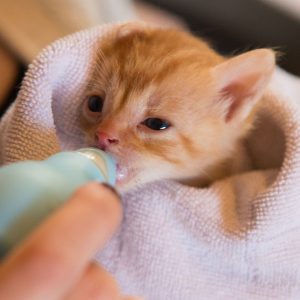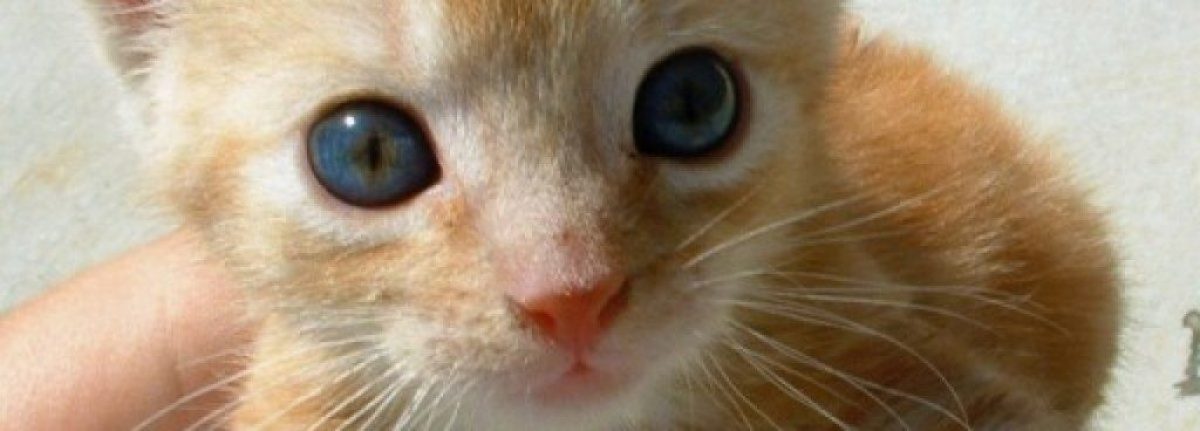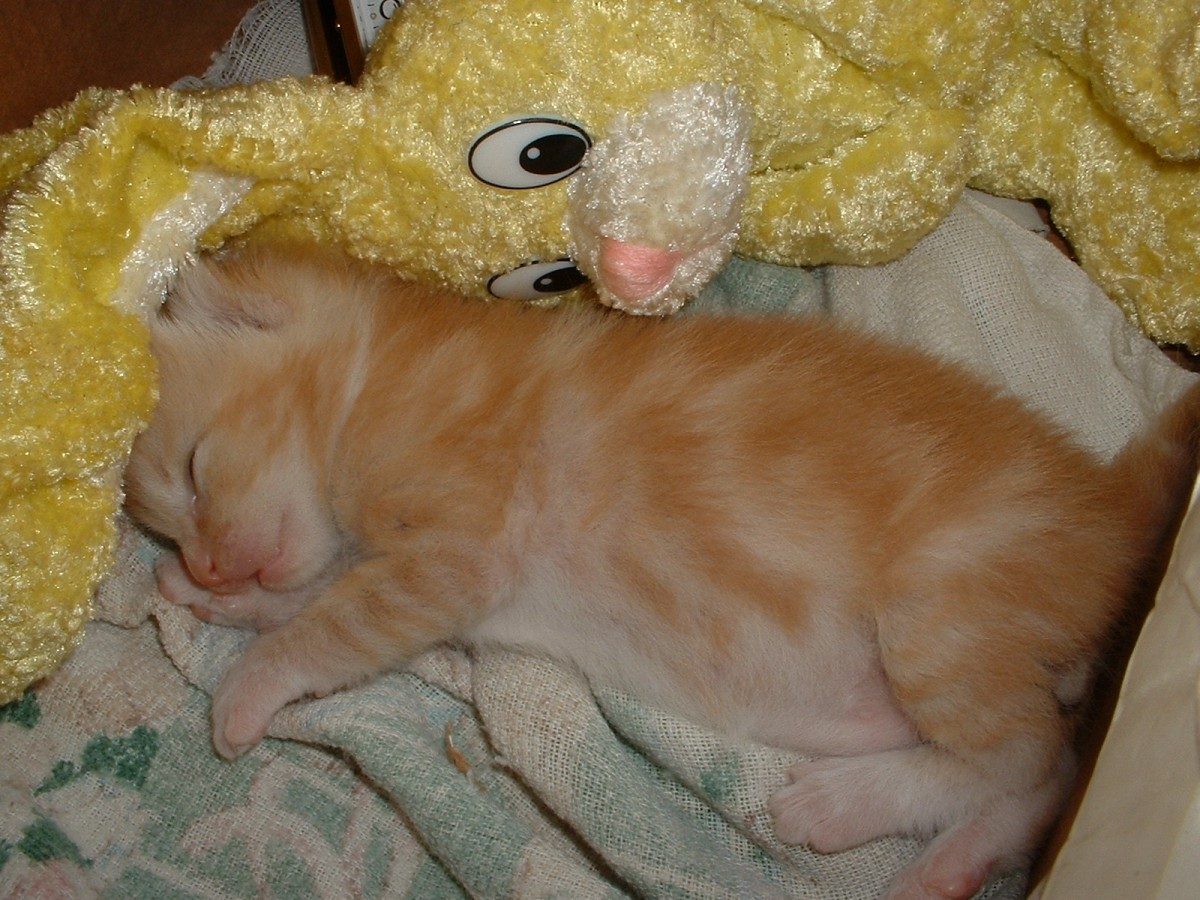
Unfortunately, cow’s milk is not nutritious enough for kittens – they will slowly starve to death on it. It also causes diarrhea which is extremely dangerous for young kittens. If you can’t get to a pet store right away, consult our recipes for a goat’s-milk based Emergency Kitten Formula. Your first purchase should be a pet nursing kit and kitten formula, available at pet stores. The nursing kit usually includes a bottle, several extra nipples, and a cleaning brush. Cut an “X” in the tip of your first nipple with scissors. Kitten formula (brands include KMR and Just Born) is more economical if purchased in powdered form to be mixed as needed. Pet supply catalogs offer very good values on these products. We recommend www.countrysidepet.com or www.valleyvet.com.
Some fosters prefer the Catac brand kitten feeders, which feature a specially shaped bottle and nipple, but these are harder to find. You know that you have made the nipple opening just big enough if, when the bottle is held upside-down, formula drips slowly from it. Too small an opening will make kittens work too hard to get their formula, tiring them out before they’ve had enough to eat. Too large an opening will force too much formula into them, too fast.
Before each feeding, sterilize the bottles and nipples by boiling them in water. Formula should be warmed to room temperature. You can do this by microwaving it in the bottle for no longer than 10 seconds (never let it boil), or placing the bottle in a bowl of hot water for a few minutes. Before each feeding, you should also wash your hands thoroughly. It’s a good idea to wash your hands again after you’re done with the kittens each time. This way, the kittens and your own pets will be protected against one another’s germs. An alternative to this is to purchase a box of latex surgical gloves and use a new pair for each feeding.
Many fosters like to keep a special t-shirt, sweatshirt, or apron in the room where the kittens are kept, and slip it on before feeding and removing it afterwards. Some viruses can live on clothing, and this can help prevent cross-contamination to and from other animals in the house. Kitten positioning for feeding is very important; this is where the crucial surrogate-mom bonding happens. Different people have different “styles” of bottle-feeding. Kittens are most comfortable in a position similar to the position they’d be in if they were nursing from a momcat. One position is simply to place the kitten on its stomach on a towel or cloth on which it can cling; it will “knead” its paws on instinct. You can also sit cross-legged on the floor with the kitten inside your legs, and let the kitten place its paws on your leg as it nurses. Remember to keep a towel on your lap for this– and use a fresh, clean towel each day.
Open the mouth gently with the tip of your finger and slip the nipple in. Once your kitten gets the hang of it, they will search out the nipple enthusiastically! You will feel a real “vacuum effect” when the kitten gets into suckle mode. To keep air from getting into the kitten’s stomach, hold the bottle at a 45-degree angle, keeping a light pull on the bottle. The kitten should be allowed to suck at its own pace. If a kitten refuses to take the nipple or won’t suckle, try rubbing it vigorously on its forehead or stroking its back. This replicates the activity of a momcat’s cleaning and can effectively stimulate the kitten to nurse. Sometimes you will hear a “clicking” noise which means the kitten’s nursing instinct is in gear and should be ready for the nipple. Sometimes a kitten is simply picky; there are two kinds of nipples out there, one shorter and one longer, so you might have to make sure they don’t prefer one or the other.
Kittens who seem too weak to nurse can often be stimulated by rubbing some Karo syrup on the lips. If a kitten still refuses to nurse, and this happens beyond the first few “getting the hang of it” times, it indicates illness. The kitten should be put on Amoxicyllin; if it does not respond in 10-12 hours then you should take the kitten to the vet.
Kittens have been known to accidentally suck formula into the lungs; if this happens, hold the kitten upside down until it stops choking. A kitten should eat about 8cc of formula per ounce of body weight per day (1 ounce = 30cc so this is just under 1/4 ounce of formula per ounce of body weight). Nursing bottles are marked with measurements so it’s easy to keep track. Weigh the kittens daily to calculate the amount of formula they need; a kitchen or small postal scale should be used. Kittens under one week old should be fed every 2-3 hours; at two weeks old they can be fed every 4-6 hours; after three weeks old, until they are weaned, they should be fed every 6-8 hours. Divide their needed daily intake by the number of required daily feedings, and you’ll know how much they should eat each time. Kittens who are extra weak or recovering from a “crash” may need to eat more frequently.
Keep in mind that the younger kittens are, the more accustomed they are to staying “latched onto” a momcat’s nipple all the time, nursing small amounts periodically. If you notice that your kittens are not eating enough in one feeding, increase the frequency of feedings.
If you’re feeding multiple kittens, you’ll have better luck with them eating the required amount if you feed them each several times, taking turns. Feed the first kitten until it stops nursing, feed the second, etc. Then go back to the first and repeat this round-robin. Usually after 2 or 3 nursing turns, a kitten has had enough for one feeding.
When a kitten has had enough formula, it will usually get some bubbles around its mouth and its tummy will be very rounded, almost pear-shaped. After feeding, you should burp the kitten just like you’d burp a human baby; hold it upright against your shoulder and pat it on the back. Do not overfeed kittens, since this can cause diarrhea and a host of other problems. Kittens under four weeks will go happily to sleep after they’re fed and full; older kittens will want some serious play and cuddle time.
It’s natural for kittens to suckle on each other or on your fingers, even after they’re finished eating. This is harmless unless you notice that this kind of activity is causing irritation to other kittens’ fur or skin.

